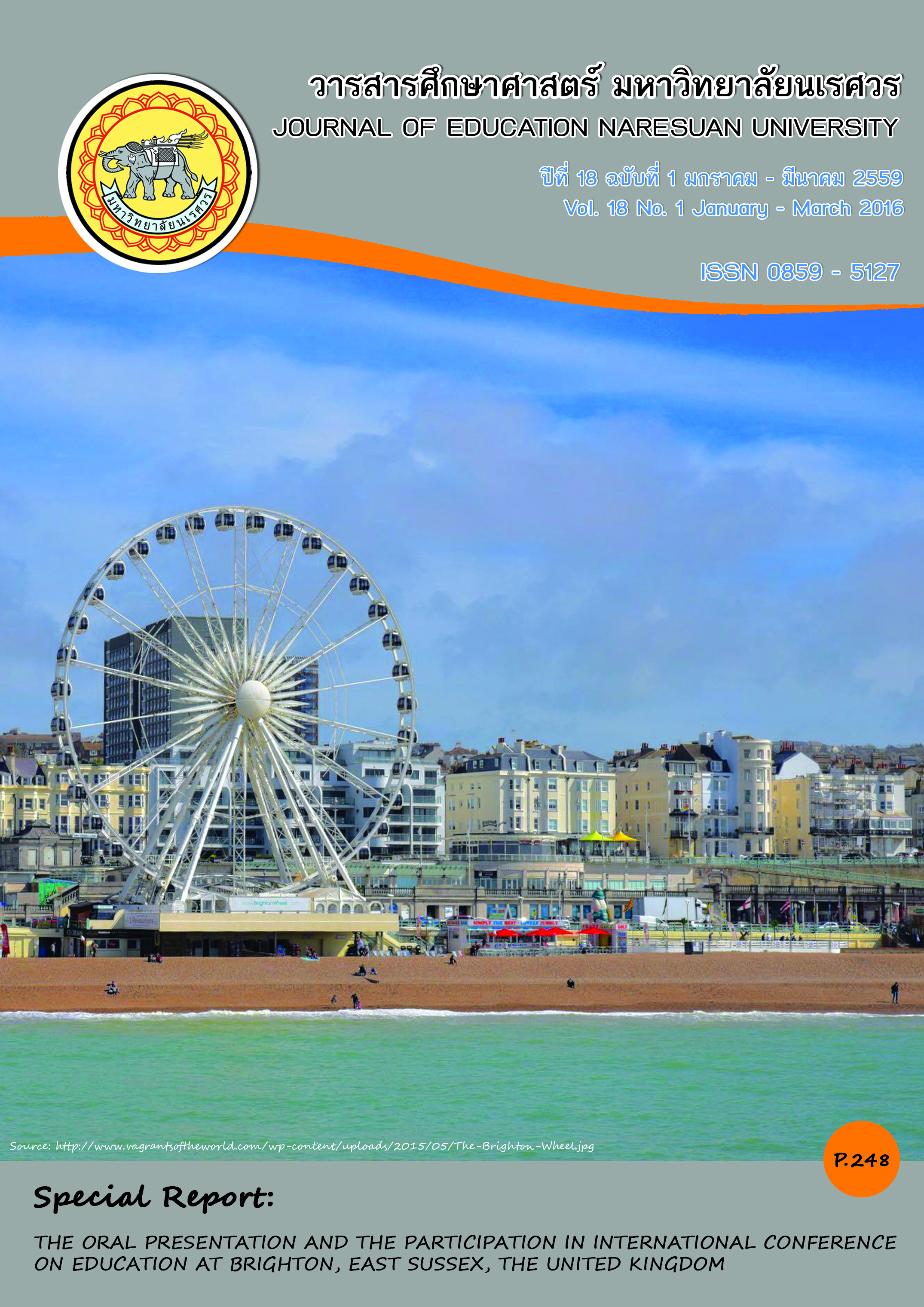การพัฒนารูปแบบการเรียนการสอนตามแนวทฤษฎีการเรียนรู้เพื่อสร้างสรรค์ด้วยปัญญา กรณีศึกษา เรื่อง การออกแบบและวิเคราะห์ระบบควบคุม DC มอเตอร์ด้วย PID
Main Article Content
Abstract
บทคัดย่อ
การวิจัยครั้งนี้มีวัตถุประสงค์เพื่อ 1) พัฒนารูปแบบการเรียนการสอนตามแนวทฤษฎีการเรียนรู้เพื่อสร้างสรรค์ด้วยปัญญา 2) หาประสิทธิภาพของรูปแบบ และ 3) ศึกษาผลการใช้รูปแบบการเรียนการสอนที่พัฒนาขึ้น กรณีศึกษา เรื่องการออกแบบและการวิเคราะห์ระบบควบคุม DC มอเตอร์ด้วยตัวควบคุม PID ขั้นตอนการวิจัยประกอบด้วย 1) การออกแบบรูปแบบการเรียนการสอน 2) การออกแบบเนื้อหาแบบบูรณาการ 3) การออกแบบสื่อการเรียนการสอน 4) การประเมินเครื่องมือสำหรับการวิจัยโดยผู้เชี่ยวชาญทางด้านการศึกษาและด้านวิศวกรรม จำนวน 9 คน ซึ่งผลการประเมินความเหมาะสมของรูปแบบการเรียนการสอน ICAE-Model มีความเหมาะสมระดับมาก (ค่าเฉลี่ย = 4.36, S.D. = 0.69) 5) นำไปทดลองกับกลุ่มตัวอย่าง ซึ่งเป็นนักศึกษาระดับปริญญาตรีสาขาครุศาสตร์ไฟฟ้า คณะครุศาสตร์อุตสาหกรรม มหาวิทยาลัยเทคโนโลยีพระจอมเกล้าพระนครเหนือ ที่เรียนวิชาการควบคุมแบบป้อนกลับ (Feedback Control) จำนวน 29 คน ผลการวิจัย พบว่า 1) รูปแบบการเรียนการสอน ICAE Model ที่พัฒนาขึ้นประกอบด้วย ขั้นแนะนำ (Information) ขั้นสร้างความรู้ (Knowledge Construction) ขั้นประยุกต์ใช้ความรู้ (Application) และขั้นประเมินผล (Evaluation) 2) รูปแบบการเรียนการสอนมีประสิทธิภาพตามเกณฑ์ประสิทธิภาพ E1/E2 ที่ 70.14/70.07 เป็นไปตามเป้าหมายที่กำหนดที่ 70/70 3) ผลสัมฤทธิ์ทางการเรียนหลังเรียนสูงกว่าก่อนเรียนอย่างมีนัยสำคัญทางสถิติที่ระดับ .05 ผลการวิเคราะห์พัฒนาการกระบวนการเรียนรู้ของผู้เรียนโดยใช้แบบประเมินกระบวนการทำงาน จากการเรียนการสอน 4 สัปดาห์ พบว่า ผู้เรียนมีพัฒนาการกระบวนการเรียนรู้เพิ่มขึ้นอยู่ในระดับดี และผู้เรียนมีความพึงพอใจต่อรูปแบบการเรียนการสอนอยู่ในระดับดี
คำสำคัญ: ทฤษฎีการเรียนรู้เพื่อสร้างสรรค์ด้วยปัญญา/ การพัฒนารูปแบบการเรียนการสอน/
การออกแบบเนื้อหาแบบบูรณาการ
DEVELOPMENT OF AN INSTRUCTIONAL MODEL BASED ON CONSTRUCTIONISM THEORY: A CASE STUDY OF ANALYSIS AND DESIGN OF DC MOTOR CONTROL SYSTEM WITH PID
Abstract
The objectives of this research were 1) to develop the instructional model based on constructionism 2) to find the efficiency of instructional model and 3) to examine students’ learning process improvement after participating in a module of Analysis and Design of DC Motor Control system with PID. The study comprised 5 steps: 1) instructional model design; 2) instructional content integration; 3) instructional material design; 4) the research instruments were then validated by 9 experts in the field of education and engineering; The appropriateness of the ICEA Model was at the high level ( = 4.36, S.D. = 0.69); 5) the instructional model was implemented with 29 undergraduate electrical engineering students enrolling in Feedback Control course at the Faculty of Technical Education, King Mongkut’s University of Technology North Bangkok. The findings showed that 1) the ICEA Model was designed to adopt four instructional phrases. They included (a) Information, (b) Knowledge Construction, (c) Application, and (d) Evaluation, respectively. 2) The level of effectiveness index (E1/E2) of the developed model was 70.14/70.07, which was in the line of the criteria set 70/70. 3) It was also found that the students’ post-test mean scores were significantly higher than the pre-test mean scores at a significance level of .05. Moreover, results from Student Performance Self-Evaluation Form indicated positive changes in students’ learning process after 4 weeks of intervention. In addition, students reported a high level of satisfaction with the ICAE Model.
Keywords: Constructionism/ Development of Instructional Model/ Integration Content Design
Article Details
The owner of the article does not copy or violate any of its copyright. If any copyright infringement occurs or prosecution, in any case, the Editorial Board is not involved in all the rights to the owner of the article to be performed.


